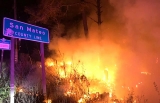Redwood City – The County of San Mateo is making it easier for property owners to remove highly flammable eucalyptus and trees of certain other species to create fire breaks near homes and escape routes.
Effective July 1, 2021, property owners in unincorporated areas of the county no longer need a permit to remove certain large trees located within 100 feet of homes or 30 feet of an escape route on public or private property. Trees that can be removed without a permit are eucalyptus, pines, acacia, tan oak and bay.
“We’ve taken a hard look at the areas most at risk for wildfires,” said San Mateo County Supervisor Don Horsley, whose District 3 includes much of the county’s coastside.
“Reducing the fuel load by removing trees helps in two big ways. First, it lessens the risk for the types of devastating fires we’ve seen here locally and across California in the past year,” Horsley said. “And second, it gives firefighters what they call the defensible space they need to protect lives and property.”
The County is waiving the tree-removal permit for one year, from July 1, 2021 to July 1, 2022. The waiver also saves property owners the normal $350 permit fee.
Property owners must still apply for a permit before removing “significant” redwood, Douglas fir, oaks (other than tan oaks), maples, buckeyes and other trees not covered by this permit exemption.
While the exemption includes all of unincorporated San Mateo County – that is areas not within cities – the focus is on the heavily forested areas along Skyline Boulevard and west to the Pacific Ocean.
“As we saw last year during the CZU Lightning Complex, local wildfire conditions are becoming increasingly dangerous. In one 24-hour period last August, we saw more acres of San Mateo County consumed by wildfire than in the previous 100 years combined,” said Ian Larkin, unit chief for CalFire’s San Mateo-Santa Cruz Unit.
“Since then, we have received below average rainfall that has resulted in exceptional drought conditions, widespread tree mortality, and below average fuel and soil moistures,” Larkin said.
The CZU Lightning Complex last summer burned about 135 square miles in southern San Mateo and northern Santa Cruz counties. It was one of a series of devastating wildfires that made 2020 the worst year on record for fires in California.
The County worked with numerous agencies and organizations, including Cal Fire and the San Mateo Resource Conservation District, as well as with large landholders, such as the Peninsula Open Space Trust (POST), to craft the exemption.
How the Exemption Works
As described in a formal Notice Regarding Permit Exemption for Tree Removal, the exemption applies to hazardous trees that present a significant fire hazard risk and a hazard to life and property.
Anyone who removes trees covered by the exemption must have written permission from the property owner. They are also responsible for ensuring that all debris is chipped and retained on site or disposed of properly.
Need help identifying if a tree is covered by the exemption? Contact the Resource Conservation District at fire@sanmateoRCD.org.

Helpful Information:
Read criteria and requirements for tree removal work.
Letter from CalFire supporting permit exemption.
###